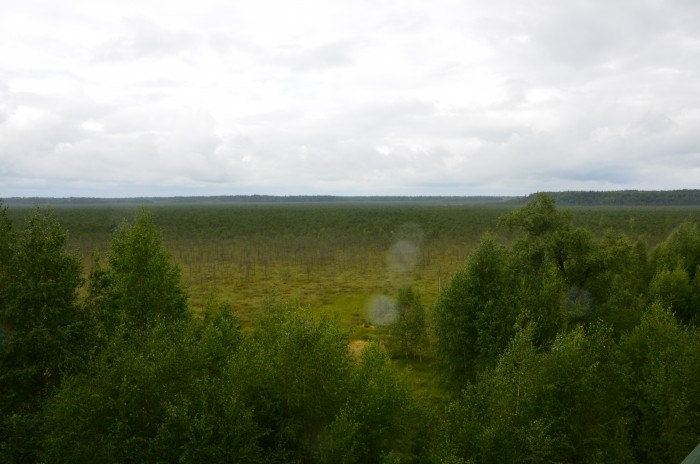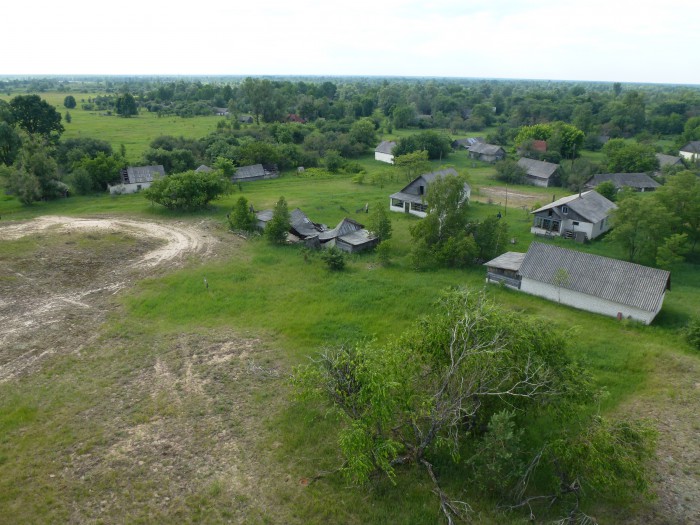21st August 2015
Habitat

A few weeks ago I had the delight of taking off my shoes and socks, rolling up my trousers and walking onto a raised bog. I actually stepped onto a bed of moss.
It was a nice feeling walking on soft moss and gently sinking. It was also a bit unnerving as my footsteps slowly filled with water. My guide assured me that, if I sank to the bottom, the water and moss would only come up to my chest. I decided to play safe, and didn’t walk very far out into the bog.
A raised bog is where the bottom of a bog becomes sealed by deposits, and no ground water permeates it. All the water in the bog comes from rain. So it is acidic and very poor in nutrients – but full of moss. Any trees that manage to take root are stunted and very slow growing. The trees in the photograph below are apparently over 100 years old.

The bog was part of the 85,000 hectare Berezinsky biosphere reserve, which was established in 1925. It’s a large area of mires and bogs that surround a 100 km stretch of the Berezina river (although as the crow flies it’s only about 50 km north to south), about 120 km north east of Minsk.
Belarus is particularly well endowed with wetlands, because the terrain is relatively flat. The watershed between the rivers that flow north east into the Baltic Sea and those that flow south into the Black Sea is in places barely 140 metres above sea level. As a result, there is very little current on the rivers of Belarus.
Drainage is therefore a major problem for agriculture. Whenever I travel outside of Minsk, there always seems to be someone in a tractor digging out dykes and drainage channels. The constant struggle to keep the land drained was an element in the books of the Belarusian novelist, Ivan Melezh, author of the trilogy Palesse Chronicles, about the harsh rural life during collectivisation.

But these areas are important because many other wetlands around the world are under threat from urban development and intensive agriculture. Given the challenges our planet faces, such places are havens of habitat for all sorts of species. We need to protect them if we are to preserve the biodiversity of our world.
This is not a new concern. As long ago as 1971, countries agreed the Ramsar Convention on “Wetlands of International Importance, especially as Waterfowl Habitats”. Named after the city in Iran where it was signed, it committed signatory states to conserve designated wetlands for their economic, cultural, scientific, and recreational value. There are nine Ramsar sites in Belarus, of which Berezinsky reserve is the largest.
Belarus has other habitats of international importance. I wrote recently about my visits to the ancient forests of the Belavezhskaya Pushcha in the south west of the country, which first became a national park in 1932. The forests are full of different varieties of oak, some of which are over 500 years old. I was fascinated by the very straight railway lines that the Germans built across the Pushcha during the First World War, and which today are paved roads.

Two years ago, I had the opportunity to visit the Polesie State Radioecological Reserve, which is part of the large Polesie marsh area that runs alongside the Pripyat river in south Belarus, the region where Melezh based his novels. The reserve was created in 1988 in the exclusion zone around the Chernobyl nuclear power station.
The explosion at the power station and subsequent release of radioactive particles was a terrible tragedy for those who lived in the area. The reserve is dotted by deserted villages where the wooden houses are slowly rotting away. As the land is still contaminated, there is no chance to use it for cultivation. In the absence of humans, nature has moved back in, with animals like bears, lynx and wolves returning for the first time in many years.
I visited the reserve with a group of British scientists who were considering the possibilities for research on “re-wilding”, because of this absence of humans. As we found out, it’s not completely deserted as there is a community of wardens whose main task is to stop natural fires in the forests that might release more radioactive material into the atmosphere. I fear they may have been busy this year because it has been so dry.

The Polesie reserve is an extreme example of de-population. There are remote villages in other parts of Belarus which are “returning to the wild”, as the population ages and people move to the cities and larger towns of Belarus. Across the country, there are many lakes and forests which few people visit and which are relatively undisturbed.
These habitats are a great asset to Belarus.
They are of great value because they harbour so many species of flora and fauna that are under threat elsewhere. This makes them of interest to scientists undertaking ecological research on flora and fauna, especially in areas without, or with very limited, human activity.
There is the chance to extract return from tourism to such unique places. My guide at the Berezinsky reserve explained how they allow limited numbers of tourists to canoe and cycle along certain paths in the reserve. They only have about 40,000 visitors a year, but they can stay the night at a few hotels within the reserve. This income helps pay for the maintenance and staff in the reserve.
Belavezhskaya Pushcha can take far more visitors – nearly ten times more can visit than to the Berezinsky reserve. The park management organise trips to watch the bison, like the one they kindly organised for me. And there is now a visa free border crossing for visitors on foot and bicycle to visit from Poland. Sadly, contamination rules out allowing such numbers into the Polesie reserve. But there is still value from allowing access to scientists.
With forests covering nearly 40% of the land, and with thousands of lakes, Belarus has some great open places to visit.